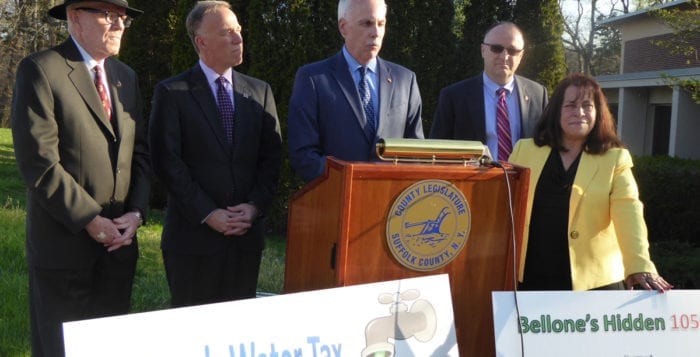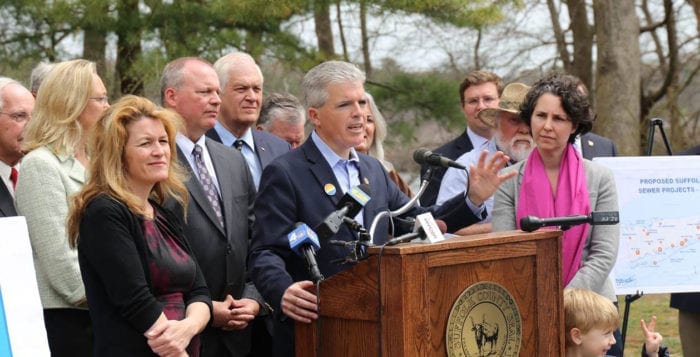By Desirée Keegan
Rocky Point residents are flooded with emotion over the rise in water level during recent storms.
As rain fell on King and Oxalis roads during the heavy rainfall Aug. 18, residents reached out to Brookhaven Town’s highway department in search of answers as to why their questions of concern have not been answered.
“I know we sound like a broken record regarding the flooding conditions at King and Oxalis, but I am writing to continue to follow up on this situation,” Rocky Point resident Sara Wainwright wrote in a letter to the highway department. “We’ve been complaining for years about the flooding, which used to be occasional, and now occurs nearly every time it rains.”

She said, and the highway department confirmed, that additional drains were added, but Wainwright claims they’re in places where they do not help to relieve the flooding, and said the town has to send out manpower and equipment to pump the drains almost every big storm.
“My husband, Frank, had a lengthy conversation with Kevin from the highway department, and members walked the property,” said Wainwright, who lives on King Road right across from the Oxalis intersection. “We suggested and Kevin agreed to look into installing additional drains on our property in front of our trees. We have heard nothing else on this since, and the conditions have continued to deteriorate with every storm.”
Brookhaven Town Highway Superintendent Dan Losquadro (R) said that 12 drainage structures have been installed in the specific area of Rocky Point over the last year to alleviate flooding conditions. He said the cost of the systems was more than $70,000.
But Wainwright and her neighbors say the streets are still dangerous during heavy rain.
“This is the worst we have seen from rain alone — the water is nearly up to my neighbor’s front walkway,” she said Aug. 18. “Highway department workers did drive by and they did mention there are other flooding conditions today, however this is an ongoing issue that I have been requesting help with for several years. Please do not try to pacify me with ‘we had lots of flooding everywhere today.’ Even the fire department sent out warnings to responders that the road is closed due to flooding here.”
Losquadro responded that “flooding everywhere” is part of the problem, but said recent studies have shown that there is still a drainage issue in the vicinity.
“When we have significant rain events like this morning — when nearly four inches of rain fell within a few hours — most drainage structures will struggle to dissipate the runoff quickly enough to maintain a water-free surface,” he said. “I am well aware of the conditions experienced this morning both in Rocky Point and across central and northern Brookhaven Town and immediately dispatched crews to these areas to pump out existing drainage structures to alleviate flooded road conditions.”
Wainwright said that cars still speed down the road as flooding persists, and said this summer a man was trapped in his car when it died as he passed through.

“Please let me know how the town plans to proceed to resolve this issue as opposed to using our tax dollars to send out, and put at risk, employees and equipment,” Wainwright wrote in the letter. “Cars travel very fast down this road and have no regard for your workers, unfortunately. Another time, a police car became stuck, and multiple others of cars travel so fast they send a wake over my treetops. I think you get my point.”
Brookhaven Town Councilwoman Jane Bonner (C-Rocky Point), who has lived in Rocky Point for the last 30 years, has witnessed the issue firsthand, and receives concerned calls and emails regarding the matter.
“Residents send me photos and ask for my help,” she said. “The highway department and Dan Losquadro have been doing a great job paving roads, repairing drains and putting out massive storm water infrastructure. As a resident of Rocky Point I know some flood spots are better than others, and I’m thankful I live at the top of a hill, but I have seen when the rain stops, it does drain pretty quickly. It’s a matter of massive pileup over a short period of time.”
Wainwright said at the very least, she feels there should be street signs indicating the risk of flood conditions, and a warning to signal drivers to slow down as they move through the at-risk streets.
“I’m concerned as the season progresses that we will see more rain and possibly tropical storm and hurricane conditions,” Wainwright said in her letter. “My neighbors and I should not need to worry about flooding at elevation — you must understand that is ridiculous. We are all taxpayers. Please communicate to us as to how you plan to use the money that we have all been paying to remedy this safety issue.”
Losquadro said his engineering division recently completed a drainage study in and around the area of King and Oxalis roads, and came to the conclusion that there is still some concern.
“I will be moving forward with additional drainage infrastructure to handle more volume than what had been designed for in the past,” he said, “thereby preventing this condition from happening again.”

















